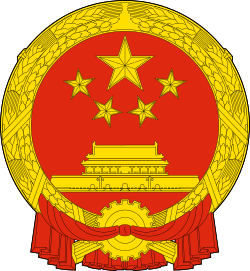New Eurasian Land Bridge

The New Eurasian Land Bridge, also called the Second or New Eurasian Continental Bridge, is the southern branch of the Eurasian Land Bridge rail links running through the People's Republic of China. The Eurasian Land Bridge is the overland rail link between East Asia and Europe.
Routes
Due to a break-of-gauge between standard gauge used in China and the Russian gauge used in the former Soviet Union countries, containers must be physically transferred from Chinese to Kazakh railway cars at Dostyk on the Chinese-Kazakh border and again at the Belarus-Poland border where the standard gauge used in western Europe begins. This is done with truck-mounted cranes.[1] Chinese media often states that the New Eurasian Land/Continental Bridge extends from Lianyungang to Rotterdam, a distance of 11,870 kilometres (7,380 mi). The exact route used to connect the two cities is not always specified in Chinese media reports, but appears to usually refer to the route which passes through Kazakhstan.
All rail freight from China across the Eurasian Land Bridge must pass north of the Caspian Sea through Russia at some point. A proposed alternative would pass through Turkey and Bulgaria,[2] but any route south of the Caspian Sea must pass through Iran.[1]
Freight
As of 2013 express freight trains were being used by manufacturers such as Hewlett-Packard to ship products from factories in the interior of China though Kazakhstan, Russia, Belarus, and Poland to Europe. The Customs Union of Belarus, Kazakhstan and Russia reduces inspections, delays and theft. Shipment from a factory in a city in central or western China such as Chongqing or Chengdu to distribution centers in Europe takes about 3 weeks; less than the 5 weeks taken by ship transport but 25% more expensive. Air freight, including processing, takes about a week, but costs 7 times as much as rail and adds 30 times more carbon to the atmosphere. Freight containers are sealed and heavily guarded. Armed guards accompany the trains. Freight traffic is projected by Kazakhstan to increase by several orders of magnitude by 2020, from thousands to millions of freight containers shipped annually.[1]
References
Notes
- 1 2 3 Keith Bradsher (July 20, 2013). "Hauling New Treasure Along the Silk Road". The New York Times. Retrieved July 21, 2013.
- ↑ "China Invites Bulgaria to Join High-Speed Asia-Europe Rail with Turkey". noinvite.com. October 28, 2010. Retrieved July 21, 2013.
- Batbayar, S. (April 8, 2009). "Global crisis delays Mongolia-Europe rail freight project". Montsame News Agency.
- Fu, Jing (August 27, 2004). "UN promotes role of Eurasian continental link". China Daily. p. 2.
- International Railway Journal (March 2008). "Just 15 days after leaving Beijing, the first demonstration intermodal freight service operated by Eurasian Land Bridge between China and Germany arrived in Hamburg on January 24". p. 7.
- Mirak-Weissbach, Muriel (August 2, 2000). "Iranian President's Visit to China Advances Strategic, Cultural Dialogue Part 1". Tehran Times.
- Ren, Daniel; Lilian Zhang; Will Clem (June 11, 2009). "Jiangsu coast to act as catalyst for growth: Region will be turned into a transport hub". South China Morning Post. p. 5.
- Xinhua News Agency (November 24, 2008). "Experts propose developing SW corridor of third Asia-Europe land-bridge".
- Xinhua News Agency (July 1, 2007). "NW China mulls "New Silk Road" exhibition park".
- Xinhua News Agency (June 21, 2007). "China northwest city to host UN meet on Eurasia continental bridge 29 Jun-4 Jul". BBC Monitoring.
- Xinhua News Agency (March 11, 2004). "China: Congress deputies propose free trade zones along continental bridge". BBC Monitoring.
Web
- China Daily (March 18, 2004). "New railway linking China, Europe to be built" (Newspaper article). Communist Party of China. Retrieved November 11, 2009.
- Ōtsuka, Shigeru (September 2001). "Central Asia's Rail Network and the Eurasian Land Bridge" (Journal article). Japan Railway and Transport Review. East Japan Railway Culture Foundation. Retrieved November 11, 2009.
- Rodrigue, Jean-Paul (1998–2009). "The Northern East-West Freight Corridor (Eurasian Landbridge)". The Geography of Transport Systems. Department of Global Studies & Geography, Hofstra University. Retrieved November 11, 2009.
See also
North–South Transport Corridor
